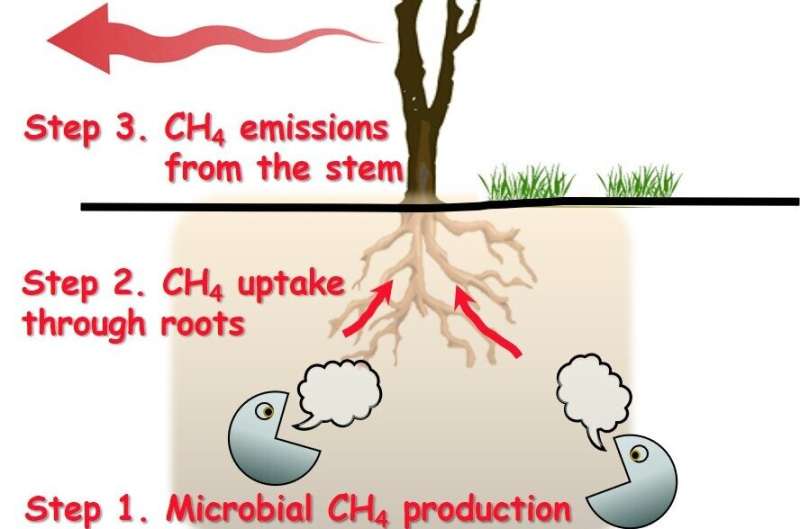Underground microbial CH4 production leads to CH4 uptake through the roots and emitted from stems of Alnus japonica. Credit: KyotoU/Kenshi Takahashi
The greenhouse gas methane, or CH4 is produced in certain tree species, but how these mechanisms actually work is a matter of volatile debate, particularly with regard to the diffusive transport of CH4 gas through the trees.
Now, a team of researchers has found diurnal variations in CH4 emission rates from the stem surface of Alnus japonica, a typical riparian wetland tree. Further examination of the tree's diurnal behavior has shown that part of its emission rate is proportional to sap flow.
"Our results suggest not only a possible mechanism [through which] CH4 molecules dissolved in the sap become volatile—enabling emission from tree trunks—but also inspire a separate hypothesis that emission rates are independent of sap flow," says lead author Kenshi Takahashi.
By taking year-round measurements of CH4 flux and sap flux, Takahashi's team discovered that CH4 gas was indeed transported diffusively from the rhizosphere to the upper trunk, consistent with previous findings. The ratio between the sap flow-dependent and independent components in the stem CH4 emission rates varied each season and for each individual tree.
Results showed that CH4 emissions peaked shortly after 12 noon in all the sample trees. This corresponds with how the daytime increase in emissions was in sync with sap flow.
From observations of A japonica samples using optical microscopes and cryo-scanning electron microscopy, the intracellular space of the cortex and empty xylem cells in fine-root may serve as a passage for diffusively transported gaseous molecules.
"While the diurnal variation of emission rates was unexpected, we were also surprised this fluctuation was limited to the leafy seasons from spring to autumn," adds Takahashi, whose team measured the changes with near-infrared laser absorption spectroscopy techniques at their study site in Shiga Prefecture.
Understanding the mechanisms involved in methane gas emissions from stems has implications for curtailing the effects of greenhouse gases. Also, by better identifying the sources of the emissions and quantifying them in relation to global natural and man-made CH4 emissions, better estimates may be achieved.
"However, questions remain as to whether trees play a role as pathways for diffusive CH4 gas transport from root to trunk or for dissolved CH4 in the xylem, or whether methane is produced elsewhere in the tree," concludes Takahashi.
The paper is published in the journal New Phytologist.
More information: Kenshi Takahashi et al, Insights into the mechanism of diurnal variations in methane emission from the stem surfaces of Alnus japonica, New Phytologist (2022). DOI: 10.1111/nph.18283
Journal information: New Phytologist
Provided by Kyoto University
























